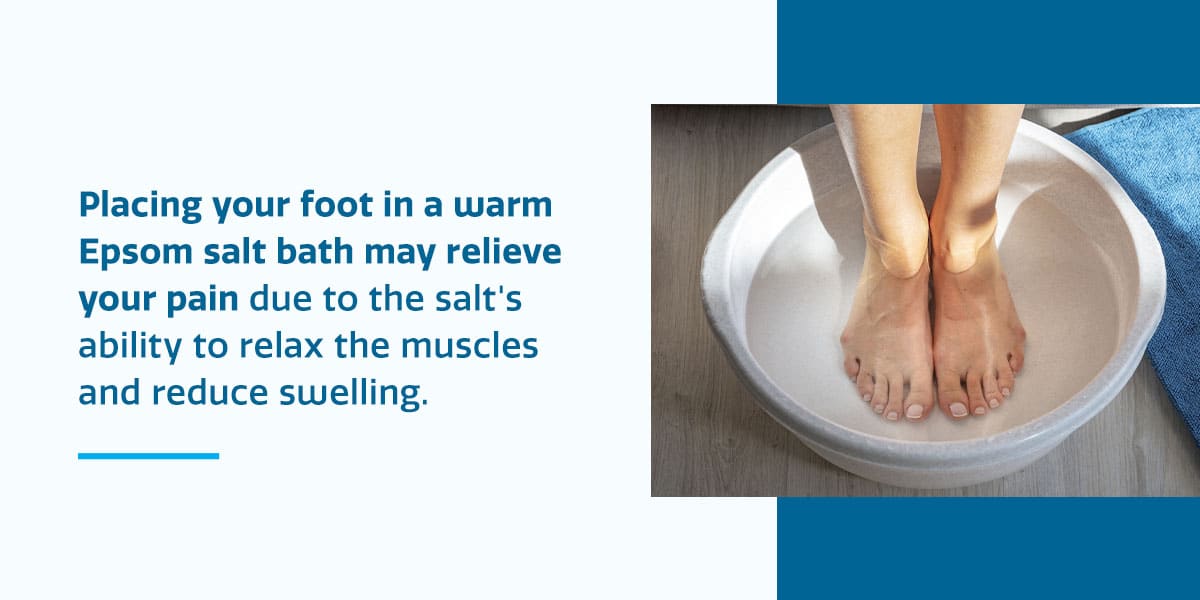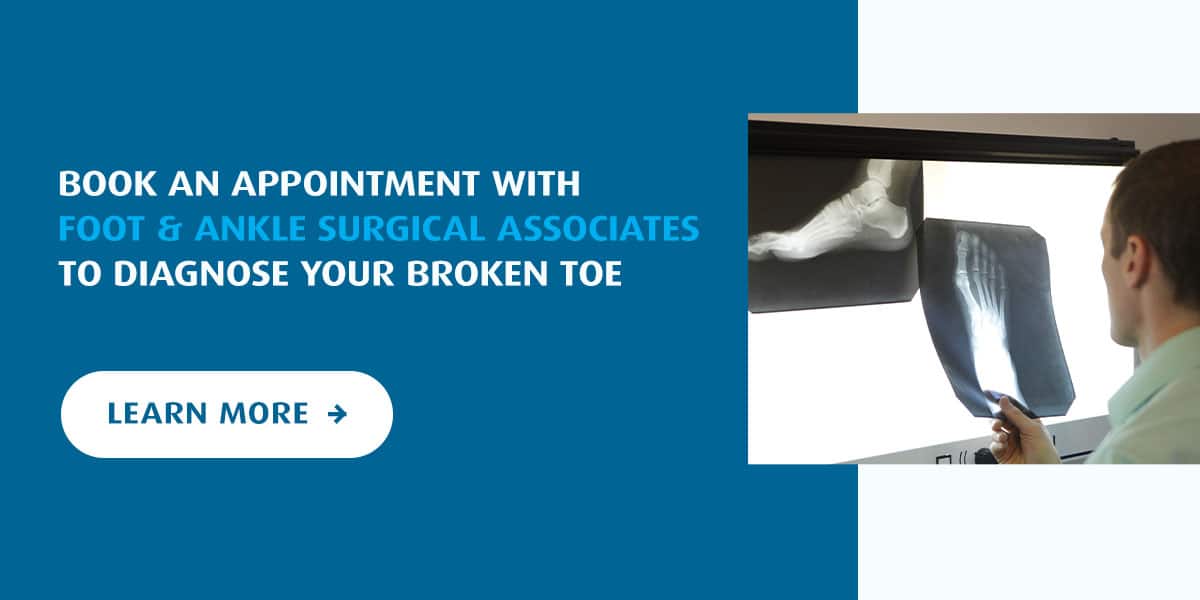
Besides being painful, a broken toe is inconvenient. Since your toes support your body weight and push your body forward when you walk, a fracture can dramatically impact your mobility and prevent you from doing daily activities.
Whether you’re seeking guidance on dealing with a recently broken toe or need aftercare tips, we’ll cover the importance of recognizing and treating a broken toe, how to protect it from further injury and possible complications associated with it.
What Does a Broken Toe Look Like?
You may have accidentally walked into something while barefoot or dropped a heavy object on your foot, fracturing one or more toes. Since the symptoms are similar, knowing the difference between a fractured or broken toe is critical. You will experience intense pain, plus swelling, skin discoloration, bruising and difficulty walking.
We’ve described toe fracture types below.
- Stress fracture: Repetitive strain on tiny toe bones leads to hairline fractures. Athletes commonly experience this, characterized by swelling without bruising, pain when touching the site and recurring pain during active periods that subsides during rest.
- Traumatic fracture: Blunt-force trauma like stubbing your toe can cause a traumatic fracture. A non-displaced fracture means the bone isn’t broken, while a displaced fracture refers to a broken bone. You may notice immediate pain at the site lasting a few hours. Bruising and swelling may be evident the following day. In extreme cases, a broken bone may protrude and pierce your skin or make your toe look crooked and deformed.
Self-help steps and remedies can help alleviate the pain and other symptoms immediately after you’ve injured your toe. However, seek medical attention immediately if you believe you may have a broken toe. It’s best to consult a podiatrist for the proper diagnosis and treatment, depending on the severity. You may wonder what you can do for a broken toe to alleviate pain and promote healing.
How to Treat a Broken Toe
The RICE method is one of the best approaches to handling a broken toe. This acronym stands for the four steps to treat an injury at home until you get in to see your podiatrist — rest, ice, compression and elevation. Many people with minor injuries have used this tried-and-true technique for rapid relief. Elevating your foot above your heart reduces swelling and improves blood circulation, promoting healing for a faster recovery.

Placing your foot in a warm Epsom salt bath may relieve your pain due to the salt’s ability to relax the muscles and reduce swelling. Mixing hot and cold compression like ice packs and a hot water bottle can also alleviate swelling and inflammation.
Over-the-counter medications like ibuprofen or acetaminophen are usually effective in relieving the pain, but you may need prescription painkillers if you are in agony. You can apply topical antibiotics to the injured area to prevent infection if you also have a cut.
Protecting the Toe From Further Injury
Once you’ve started using the RICE method, you must avoid activities that could lead to further injury. Immobilizing the broken toe will secure it while promoting healing. The following measures help keep your toe in place to prevent movement.
Buddy Taping
If you have a less severe injury like a non-displaced fracture, you can treat it by placing gauze between the injured toe and its neighbor and taping them together. Keeping the toes close together acts like a splint. The fractured or broken toe heals faster with restricted movement.
Walking Boot or Vionic Shoes
A walking boot is a medical shoe used post-surgery or injury. Its cast-like structure keeps the foot in place to prevent movement. The boot has a rigid bottom and a soft top, providing enough wiggle room for potential swelling without compressing the foot entirely.
Vionic shoes also promote healing, offering adequate support to keep your feet comfortable while providing effective pain relief from all foot-related injuries.
Walking Cast
Your doctor may put a cast around your foot in severe cases where the breakage causes bone displacement. The cast stays in place for a lengthy period, allowing your foot to heal. This option is highly effective for injuries like a broken foot or ankle.
Caring for a Broken Toe
A fractured or broken toe can take several weeks to heal, depending on the injury’s severity and the affected toe. You can expect the healing process to last six to eight weeks with proper care, though it could take months before your full range of motion returns. Continue with the RICE method until the swelling, numbness and bruising reduce.
A health provider can offer sound advice on exercises and stretches that promote mobility without straining the injured toe. These routines help build muscle strength to support the healing process. Severely fractured, broken or damaged ligaments and tendons require more healing time with professional assistance. Your doctor might prescribe weekly physical therapy sessions, depending on your injury.
Potential Complications and When to Seek Medical Assistance
Any injury can have complications afterward. Warning signs of a broken toe to look for include:
- Increased swelling
- Persistent discomfort, despite pain meds
- Numbness or difficulty moving the toe
You should know when to see a doctor about a broken toe if complications arise or there are no signs of improvement. You might need surgical intervention for weight-bearing toes or displaced or open fractures, broken toes or an infection due to an open cut. Surgery is a long-term solution for severe injuries.
Book an Appointment With Foot & Ankle Surgical Associates to Diagnose Your Broken Toe
A broken toe is painful, but the treatment and healing process can be bearable with proper care. Knowing what steps to take when you experience a fractured or broken toe is vital. Applying ice, elevating your foot, resting and taking over-the-counter pain medication can provide temporary relief. However, some injuries require surgical treatment, so it’s best to consult a podiatrist for an accurate diagnosis.
At Foot & Ankle Surgical Associates, you’re in good hands. Our expert team includes qualified, compassionate surgeons, anesthesiologists, registered nurses and medical office personnel who all ensure a smooth and comfortable experience while you are in their care.
If you believe you may have a broken toe or another severe foot injury, call us at 360-795-5462 to discuss your concerns. Feel free to email us with any questions or concerns, and we’ll follow up.





